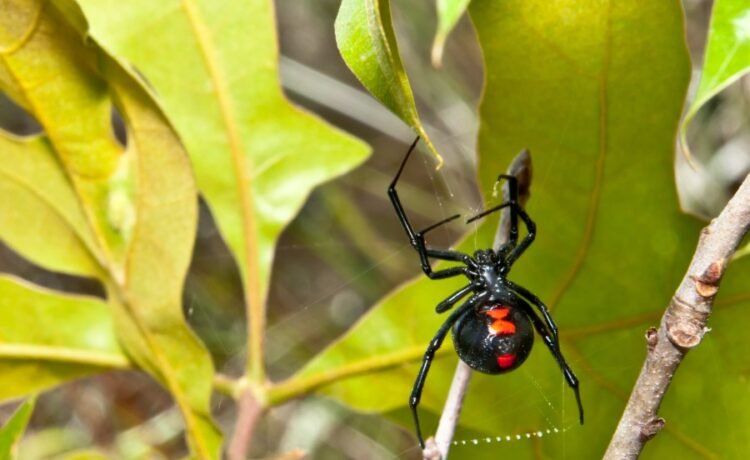RICHMOND, Va. (WRIC) — What are the most common spiders in Virginia, and which ones should you be aware of potentially biting you?
8News has compiled a list of common spiders that can be found in Virginia, as well as ways to identify each species based on its appearance.
Spiders of ‘medical concern’
According to a Virginia Cooperative Extension report by Theresa A. Dellinger and Eric Day for Virginia Tech’s Department of Entomology, all spiders use venom to kill their prey, however most species are not considered aggressive or dangerous, with bites typically occurring when a spider is handled roughly or trapped and pressed against the skin.
If a spider does bite someone, it may not inject any or very little venom into the bite. However, a few species in Virginia can produce more severe symptoms that require medical attention.
Black widows

According to the report, both northern and southern black widow spiders can be found in Virginia, with the appearance of female spiders from both species having shiny black bodies with red markings on the underside of the abdomen.
The difference between a northern and southern female black widow spider is the hourglass print on their bodies.
Southern female black widows will have both triangles of the hourglass connected in the middle and an additional red spot near the spinnerets, or the organ where spider silk is produced, at the dorsal tip of the abdomen.
Northern female black widows will lack a complete hourglass and may instead have two red bars on both the top and the underside of the abdomen, according to the report.
Immature northern and southern black widows of either sex have banded legs and white patches with red or orange dots on their abdomen. According to the report, mature males of both species retain the immature coloration and are about half the size of the female, but with proportionally longer legs.
According to the report, immature and male black widow spiders from both species are not considered to be of medical concern.
Brown recluse

According to the report, brown recluse spiders are primarily found in the Midwest and south-central states, with its natural range reaching to the tip of southwestern Virginia.
Brown recluses seldom bite and the severity of the bite can vary from person to person, with symptoms ranging from no harm at all to a severe reaction.
According to the report, the initial bite is often painless, followed by a systemic reaction within 24 to 36 hours with restlessness, fever, chills, nausea, weakness and joint pain. Tissue death may occur at the bite wound and skin can possibly shed off.
In some severe cases, a wound may develop that lasts several months. People who are very young, old or immunocompromised may see more serious symptoms
Brown recluse spiders range in color from tan to dark brown, but are often golden brown with no stripes or bands on the legs. They belong to a group of spiders commonly known as violin spiders, or fiddlebacks, due to a fiddle-shaped marking near their head region.
According to the report, most spiders have eight eyes arranged in two rows, however brown recluse spiders have six eyes arranged in three groups of two, with space between each pair of eyes.
Other spiders
While these spiders may have a reputation for looking dangerous just by their size or appearance, their bites are generally mild.
Yellow sac spiders

Two species of yellow sac spiders can be found in Virginia. According to the report, the yellow sac spider species named Cheiracanthium inclusum is native to the United States, while C. mildei was introduced from Europe.
Both species are similar in size and are a light yellow or beige color with darker brown tips on the legs and mouthparts. They have a darker midline stripe that begins behind the head, but does not completely reach the tip of the abdomen. Cheiracanthium mildei may appear greenish in its color.
According to the report, both species are frequently found in or near their silken tube or “sac” that they use as a protective retreat during the day. These spiders are nocturnal ambush hunters and do not spin a web to trap their prey.
Bites from yellow sac spiders are generally mild and self-limiting in severity, according to the report. It will usually heal in a few weeks if the wound is kept clean and free of secondary infection.
Jumping spiders

Jumping spiders are described as active, hairy predators with large eyes and bold coloration. According to the report, they do not spin webs, and instead, hunt their prey by jumping onto them with surprising speed. They are commonly found outdoors on plants and manmade structures.
Wolf spiders

Wolf spiders are described as being large, hairy and active with long legs. They are typically brown with various patterns of darker stripes or spots of color on the body and legs.
These spiders are ground dwelling spiders that also hunt their prey and do not spin webs. Females carry their egg sac attached to their spinnerets at the tip of their abdomen, according to the report.
House spider

According to the report, the common house spider and spiders in the genus Steatoda are sometimes mistaken for black widow spiders, but they are not considered dangerous.
The Steatoda grossa species, also called false black widow spiders due to their resemblance, are a specialist predator of black widow spiders.
Orb weaving spider

Several species of orb weaving spiders can be found in various parts of Virginia, such as near water, the interior or edge of a forest, as well as on weedy vegetation.
According to the Farmers’ Almanac, orb weaving spiders vary in color, but are typically identified by their large, bulging abdomens covered with bold markings. They spin unique webs, usually seen with a zig-zag pattern down the center.
These spiders seldom bite and their venom does not pose a threat to humans. Orb weavers can be beneficial in gardens to help control pests.






